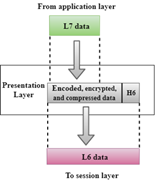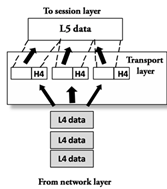OSI Layer Model
The OSI Model (Open Systems Interconnection Model) is a conceptual framework used to describe the functions of a networking system. In order to facilitate interoperability between diverse devices and applications, the OSI model describes computing functions into a universal set of rules and standards. By using the OSI layer model, we will show how data moves from the student's PC to the Online Learning System server in the Cobham College IT centre.
7. Application Layer
This layer is used by end user applications such as web
browsers and email clients. This is the only layer that directly interacts with
data from the user. These applications generate the data that must be sent
across the network.
6. Presentation Layer
This layer is primarily responsible for preparing data
so that it can be used by the application layer. It specifies how data should
be encoded, encrypted, and compressed between two devices so that it is
correctly received on the other end.
5. Session Layer
This layer is responsible for maintaining, establishing, and
synchronizing the interaction between communication systems.
The session is the period of time between when a communication is initiated and
when it is ended.
4. Transport Layer
The task of the
transport layer is to establish a temporary communication session between two
applications and transfer data between them. On the
transmitting end, the transport layer takes the data transferred in the session
layer and divides it into segments. Besides, packet delivery and error checking
are also handled by the transport layer.
3. Network Layer
The network layer is responsible for data transmission
between host that are connected to various networks. The network layer places
the IP addresses of the sender and receiver in the header.
2. Data Link Layer
The major purpose of this layer is to ensure that data
transfer from one node to another through the physical layer is none error.
1. Physical Layer
The physical equipment used in data transfer such as
cables and switches are included in this layer. It is in charge of establishing
a physical connection between the devices and contains information in the form
of bits
OSI Layer Model for Student Side:
In order to transmit human-readable information from the student’s computer to Cobham College facilities through the network, the data must be sent down to the seven layers of the OSI model on the transmitting device. The data from the Cobham College network will subsequently sent to the IT Centre, which hosts the Online Learning System server.
Data is transported from the transmitting computer down through all layers, starting from the application layer to the physical layer. Each of the layer is focused on a specific task before passing the data to the next layer. The application layer essentially acts as the interface between the student and the Online Learning System application. This is the layer where the user interacts with a mail application like Gmail or MS Outlook, or a communications package such Secure CRT for Telnet or FTP Voyager for FTP. At the student's side, it received the data from the application layer and performs data compression and encryption to it in the presentation layer. The session layer allowing the student’s computer to send the data by establishing connections and the transport layer manages the delivery and error checking of data packets. After that, the data segments received from the transport layer are broken down into smaller pieces called data packets by the network layer. When it receives the data in the form of packets from the network layer and converts it into smaller forms, it is referred to as data frame by the data link layer. The physical layer, which is the lowest layer of the OSI model, will converts the data frame into bitstreams (0's and 1's) and sends it to Online Learning System server through a modem.
7. Application Layer
At
the student side, the modem will be used to connect to the
system which will be accessed via application programmes or a website by using
any supported browser such as Chrome, Firefox, Yahoo and more. Then, the data
will be sent when a student requests an access to the system. It is provides
the interface for student to tell the computer how to handle the data.
6. Presentation Layer
At student, the process of data encryption and
compression will happen upon received it from application layer. Data
encryption will happen for the data to carry sensitive data for privacy
purpose. Encryption is a process of converting a plain text into cypher text.
Process of compression will also happen to reduce the number of bits contained
in the information. It can either be lossy or lossless in nature. Lossless
compression is mostly preferred for some important data items.
5. Session Layer
On the student
side, students will access the online learning system from the Cobham College
IT Center to verify who the user is and establish a conversation between them.
From this perspective, it will authorize and manage the files that students
want to access. Therefore, multiple applications can be allowed to send or
receive data. In addition, it has a data check that allows students to complete
the learning system and provide a utility to confirm the connection to
continue.
4. Transport Layer
On the student side, when the student uploads any file in the online learning system, the transport layer adds the port address to the header. Then, the data further undergoes the main functions of the transport layer, namely segmentation and reassembly. This layer accepts messages from the conversation layer and breaks the messages into smaller units. Each generated segment has a header associated with it. In order to deliver the message to the correct process, the transport layer header contains an address called the service point address or port address. Therefore, by specifying this address, the transport layer can ensure that the message is delivered to the correct process.
3. Network
layer
On the student side, the data which in segment format
will determine the specifc id address in IP such as the online learning system
server. Network layer will manages device addressing, tracks the location od
device on the network. This layer will determines best path for move data from
source to the destination based on the network conditions, the priority of
service and other factors. The segment will be given the sources and
destination IP address which will become the packets pass to data link layer. The
protocols in network layer are IP and Ipv6.
2. Data
Link Layer
On the student side, the packets receive from the
network layer will identifine how the data is place. The data will send into
the specific ip to make sure the data reach the destination. This layer as the
media access control and responsible for the error-free transfer of data frames
and unique identification of each device that resides on a local network. It
make sure the information is nor corrupt and pass the new data, frame to the
physical layer for transmission. The protocols for data link layer are IP , ARP
and ICMP.
1. Physical
layer
OSI Layer Model for Server Side:
The server for Online Learning System is in Cobham
College IT Centre. The server based on OSI Layer starts with physical layer. In
physical layer, information was received from student side through cable or
hub. Next is data link layer. Data link later is where the physical connected
node on a network is terminated. It will break up packet into frames and sends
them from source-to-destination. The third layers are network layers. In this
layer, it will reassemble the data packets into segments for the next layer the
transport layer. In transport layer, it will perform the reassembly and
sequencing of data. It will also read the port number of the data from the
header file, and then direct it towards the proper application. Next is session
layer. In this layer, after received data sender, which is student, then it
will be terminated in this layer to avoid wastage of resources. It will also
perform authentications for establishing a secure connection in the network.
After that, it will proceed to the next layer which is presentation. In
presentation layer, upon received the data from student, data translation will
be performed together with decryption and uncompressed the data. Lastly the
application layer. In this layer, it normally acts like an interface for
server. This layer provides services for network applications with the help of
protocols such as HTTP, HTTPS, FTP, etc...
7. Application Layer
At the server side, some resources such as HTML files and pictures are stored by the responder server. A request is made by the HTTP sender to establish a TCP connection to the server's designated port. On that port, the HTTP server wait for the requests from the sender. The server gives the sender a status line and a message body in response to the request which might be a requested file, an error message or some other information. In general, the program will read the https instructions and provide the sender permission to visit the website and allow student to use the Online Learning system.
6. Presentation Layer
In server, the process of data translation, decryption, and decompression. In this layer will ensures that information sent to server in Cobham College IT Centre. Data translation will happen to transform the high-level user language data to low-level machine level language and vice versa such as ASCII and etc… Decryption is the process of converting a ciphertext into plain text. Decompression data happened to display or process data sent by student.
5. Session Layer
On the server side, it will check whether the requested resource is available in the online learning system. If the requested resource is available, it will try to establish a connection, ensuring that the information is sent to Cobham College IT Center. If the connection fails, it will send an error message to the application layer to inform the students that the connection has failed. If successful, the layer will start and maintain sessions as needed.
4. Transport Layer
On the server side, the server confirms by setting the ACK bit and adding an acknowledgment number to the length of the received data. First, it needs to establish a connection with the online learning system server through a three-way handshake. Once the handshake is complete, it will be ready to receive packets containing actual data. Finally, the connection will be closed when they finish sending and receiving data.
3.Network Layer
On the server side, the packets receiver from the data link layer will convert to the segment. This layer will remove the IP address and header for the packets. After the packets removed the IP address and header will change back to the segment and pass to the transport layer to follow the prosses sending to the destination.
2. Data
Link Layer
On the server side, the frame receiver from the physical layer will convert to the packets. After the data was not getting error, the layer will continuous other process. This layer will removed the data link headers. Then the packets will pass to the network layer.
1. Physical
Layer
At the server side, the data will receive from the student side at the server in IT center. The layer will read the bits in form ones and zeros or the signal which receive from the transmission medium. Then the layer will convert the bits into frames and send to the data link layer.


















No comments:
Post a Comment